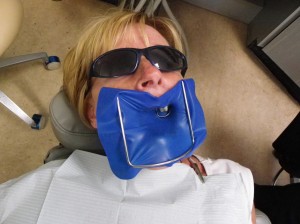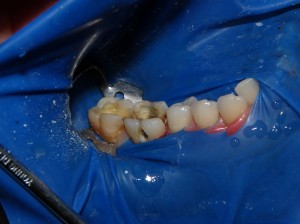Rubber dam – a secret weapon for quality dentistry
Posted: July 13, 2011
Last Modified: March 13, 2019
If you’ve been reading through our posts or our Facebook page, you will see a number cases posted where teeth are surrounded by a blue background. In fact, most of the cases you will see in progress have this same blue blackground. Why? It’s certainly not for the sake of better photography (although it definitely helps); it is a rubber dam (also known as a dental dam) for better dentistry!
Here is a recent photo of a patient in our office with the rubber dam on:

The purpose of these sheets of material is to provide protection for you (in preventing certain things from dropping down your throat such as operative debris or dental materials or instruments), but also moisture control to prevent saliva or water from coming up onto the tooth.
Almost all of our fillings are white fillings (also known as composite resins), and while much more aesthetically pleasing than silver (amalgam) fillings, are much more sensitive to moisture when being placed. Resin fillings are chemically bonded to teeth, and to ensure good bonding, they must have a clean, uncontaminated surface. These things CAN NOT get wet when being placed, otherwise the filling’s bond quality to the tooth is compromised.
Rubber dams keep all of the moisture out (and also helps keep out breath moisture), plus all other contaminants that might be lurking (saliva, plaque, etc.)
So, they are great to have on, but are they uncomfortable? It depends on who you ask:
People who grew up having dentistry done without rubber dams tend to love it, because they realize how much less debris is going down their throat.
People who gag will have problems because it can sometimes feel like they can’t swallow (they actually can, but it doesn’t feel like it).
People who have never had work done without it love to complain about the “damn dam”, but then quickly realize how advantageous it is after trying a procedure without the dam.
Here is a quick video showing how a rubber dam is prepared, and placed into the mouth. (Ignore the fact that he is not wearing gloves. Gloves are mandatory for us.) It gives you an idea of how easy it is to place one in the mouth, and also a good demonstration of how it is able to keep the tooth clean while being worked on.
Once applied, the rubber dam allows us to see the tooth much more clearly, and allows for a quicker, and for us, less stressful procedure. It gives us some more working time so we don’t feel rushed to “beat the saliva”, and gives us easier working conditions because we don’t have to keep one hand in the mouth at all times in an attempt to keep the tongue and cheek away from the tooth.
Here is a photo of the view we have with the rubber dam in place:

These squares have been around for decades, are available in various colours (blue, green, black, pink and possibly others), but more importantly, are available in regular latex rubber or nitrile for those who are allergic to latex.
We love working with rubber dams, and will use them whenever feasible.
Please contact us for a customized assessment of the state of your oral health! Thanks for reading.


